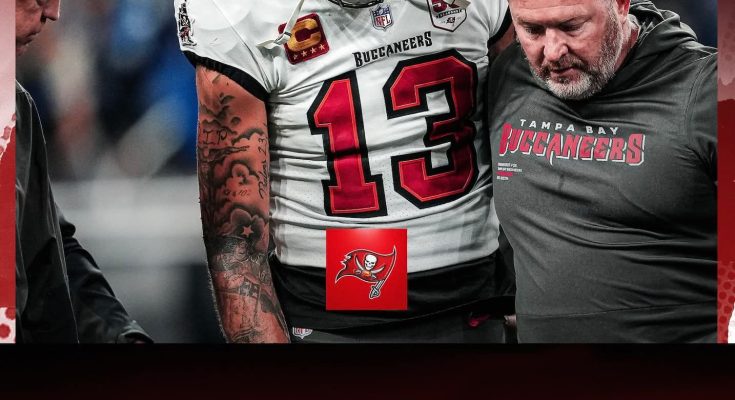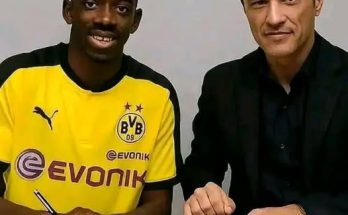It’s a devastating development for the Tampa Bay Buccaneers and their fans. Head coach Todd Bowles confirmed that star wide receiver Mike Evans will miss most of the season after suffering a broken collarbone, a significant setback for a team that has heavily relied on his leadership, consistency, and explosive playmaking ability for over a decade. The injury, sustained during what appeared to be a routine play, quickly turned into a nightmare scenario as Evans was seen clutching his shoulder and later escorted to the locker room. For a franchise already facing questions about its offensive identity, losing Evans is not just a loss of talent—it’s the loss of a heartbeat.
Mike Evans has been the face of stability for the Buccaneers since being drafted in 2014. His name has become synonymous with reliability, having recorded over 1,000 receiving yards in each of his ten NFL seasons, a feat that cements him among the league’s all-time greats. But this injury halts that streak in its tracks and forces the Buccaneers to adjust to life without their most dependable offensive weapon. A broken collarbone typically requires several weeks—often up to 10 or more—to fully heal, especially for players who depend on upper-body strength, reach, and contact balance like wide receivers. Given the nature of the injury and the cautious tone in Bowles’ remarks, the Buccaneers are preparing to be without Evans for the majority, if not the entirety, of the regular season.
The ripple effect of Evans’ absence will be felt throughout Tampa Bay’s offense. Baker Mayfield, who had found a reliable rhythm with Evans this season, will have to quickly adapt to a new receiving hierarchy. Evans was not just a go-to target on third downs or in the red zone; he was also the emotional anchor of the unit. His ability to make contested catches, draw double teams, and create mismatches against smaller defensive backs gave the Bucs a consistent advantage every week. Without him, opposing defenses can now shift coverages more evenly and potentially apply more pressure on Mayfield, forcing him to rely on younger and less proven wideouts.
Chris Godwin will now be thrust into an even greater leadership role. While Godwin has always been a high-caliber receiver in his own right, his game complements Evans’ rather than replicates it. Evans’ physical presence on the outside allowed Godwin to operate effectively in the slot and across intermediate routes. Without Evans drawing coverage, Godwin will face the challenge of being bracketed more often, forcing him to find new ways to separate and produce. It’s a test of versatility and endurance that will determine whether the Bucs’ offense can remain competitive in a division that’s still wide open.
The Buccaneers’ depth at receiver will also be tested like never before. Young talents such as Trey Palmer, Deven Thompkins, and Rakim Jarrett will suddenly have opportunities to step into larger roles. Palmer, in particular, has flashed moments of promise this season with his speed and big-play potential. However, none of these players possess the physical dominance or route precision of Evans. Their development will need to accelerate quickly under the guidance of offensive coordinator Dave Canales, who must now reimagine the offensive scheme to maximize the tools he has left.
For Bowles, this is more than just an injury to a star player—it’s a test of leadership and adaptability. The Buccaneers have been an organization in transition since the departure of Tom Brady. Evans represented one of the last remaining pillars from their Super Bowl LV championship team. His absence removes a voice of calm and confidence in the locker room, and it will fall on veterans like Godwin, Lavonte David, and Mayfield to keep the group focused. The margin for error in the NFC South is slim, and Tampa Bay can’t afford a prolonged slump, especially with key matchups against divisional rivals on the horizon.
Statistically, losing Evans is a blow that’s hard to quantify beyond the obvious numbers. He has been responsible for roughly a third of Tampa Bay’s receiving touchdowns over the last three seasons and is often the target of high-leverage plays—deep routes, fades, and sideline back-shoulder throws that extend drives or swing momentum. His connection with Mayfield had been building week after week, showcasing an impressive chemistry that mirrored his past partnerships with Jameis Winston and Tom Brady. Removing such a weapon from the field changes everything, from play-calling tendencies to defensive alignments the Buccaneers will face.
The injury also arrives at a particularly painful time for Evans personally. Entering this season, he was in the final year of his contract and seeking an extension that reflected his elite production and legacy within the franchise. Discussions between Evans’ camp and the Buccaneers’ front office had reportedly stalled, leading to speculation about his long-term future in Tampa Bay. Now, with a major injury interrupting his season, the question becomes even more complicated. Will the Buccaneers still commit to a long-term deal with a receiver entering his thirties and coming off a significant injury? Or will this mark the beginning of the end for one of the most iconic player-team relationships in recent memory?
For Evans, this is unfamiliar territory. He’s played through pain before—hamstring strains, ankle sprains, minor shoulder issues—but never something that sidelined him for such an extended stretch. Known for his toughness and professionalism, he’s rarely missed games throughout his career, often pushing through discomfort to be available for his teammates. That level of dependability has been one of his defining traits, making this injury all the more difficult for him and the organization to accept. Bowles’ tone during the press conference suggested deep disappointment but also a measure of confidence that Evans will attack his recovery with the same drive he brings to the field every Sunday.
In the short term, Tampa Bay must find creative ways to generate offense. Expect a heavier reliance on the running game with Rachaad White and potentially more two-tight-end sets featuring Cade Otton and Payne Durham. Canales will likely emphasize quick passes and screens to keep the chains moving and take pressure off Mayfield, who can’t afford to force throws into coverage now that his primary safety valve is gone. The Bucs could also explore the trade or free-agent market for reinforcements. Veterans such as Jarvis Landry or Kenny Golladay could be considered temporary options, depending on cap flexibility and system fit. But finding anyone who can replicate Evans’ production and presence is virtually impossible.
Defensively, the Buccaneers will need to carry more of the load. Bowles, a defensive-minded coach, has built his reputation on aggressive, blitz-heavy schemes that disrupt opposing quarterbacks. With Evans sidelined, the Bucs’ offense may not be as explosive, meaning the defense must shorten the field, create turnovers, and limit opponents to low scores. The synergy between both units will be more important than ever. Games that once might have been won through shootouts will now depend on grinding out possessions and winning the turnover battle.
This moment also serves as a stark reminder of how fragile success can be in the NFL. Evans’ consistency over the years has perhaps made fans take his greatness for granted. Ten straight 1,000-yard seasons—each under different quarterbacks, offensive systems, and circumstances—is a historic achievement that underscores his adaptability and skill. Few receivers have maintained such longevity and dominance. His absence will make that more evident with each passing game as the Bucs struggle to replace what he brings not just in stats but in spirit.
For younger players on the roster, this period could serve as a defining opportunity. A breakout from one of the younger receivers could alter the future direction of the team. It’s also a chance for Mayfield to prove he can carry the offense without leaning heavily on a superstar. He’s played some of the best football of his career this year, showing confidence and command, but adversity like this will test his leadership and composure. Great quarterbacks elevate those around them when the odds are against them—this is his chance to show he belongs in that conversation.
Meanwhile, the fanbase, one of the most loyal in the league, will rally behind Evans. His name is etched in franchise history alongside legends like Derrick Brooks and Ronde Barber. Even as he sits on the sidelines recovering, his influence will remain palpable. He’s the kind of player who mentors younger teammates, cheers during practice, and maintains an active presence even when injured. That leadership will be invaluable as Tampa Bay navigates this turbulent stretch.
As the season progresses, the timeline for Evans’ return will become clearer, but the Buccaneers must prepare for the worst while hoping for the best. If he can return late in the year—perhaps December or early January—it could provide an emotional lift and potentially reshape the playoff picture if Tampa Bay remains in contention. But for now, the focus must shift toward resilience and adaptation.
The NFL is often defined by how teams respond to adversity. Losing a star like Mike Evans is the ultimate challenge, but it also presents an opportunity for others to rise. Tampa Bay’s journey from here will depend on how well they adjust, how strongly they believe in their system, and how they continue to embody the toughness and competitive spirit that Evans has exemplified throughout his career. While his absence leaves a void, his influence remains—a reminder that even off the field, Mike Evans’ impact on the Buccaneers endures.



